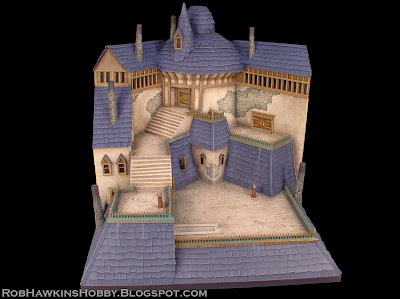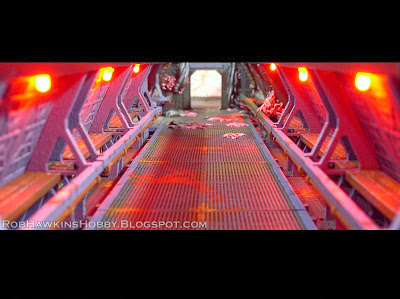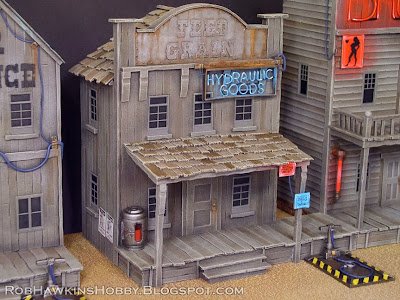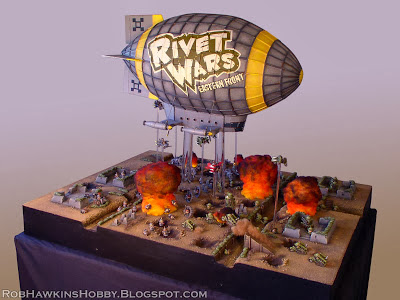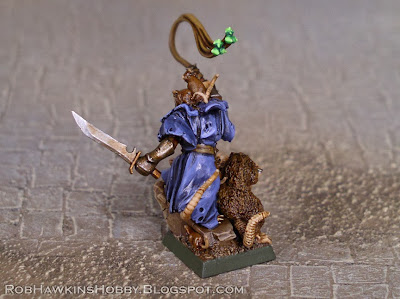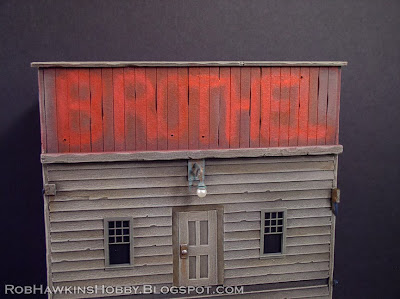Tuesday, December 31, 2013
Thursday, December 5, 2013
Movin' On Up
My wife and I bought a house recently, so most of my time has been spent preparing for the big move. I've been at Home Depot nearly every day, but not to buy terrain supplies.
This little goodie came in the mail– an official Skweel Gnawtooth, all the way from Germany. Many thanks to Andreas from Spielmann's Workbench for the model! A lot of great conversion work on his blog. Check it out: spielmannsworkbench.blogspot.com
Skweel is on the back burner until I get settled in, though. I've still got the rat ogres and a second doom wheel to finish. I went through my Skaven figure cases and reorganized them with some custom cuts to accommodate the new large models. Everything is in its case and ready to travel.
The only painting I've been able to do has been at the house. The kitchen was a bit of a nightmare due to the paint selection, but now I know to stay away from Glidden. I've always gotten Behr when mixing colors for large projects, and as it turns out, it's great for painting rooms, too! I'd rather use a large drybrush and 237 pots Cidatel paint to finish a room rather than try rolling Glidden again. Ugh.
The good news is I'll have more studio space to work on large projects. But for now, it's back to packing.
'Til next time!
Wednesday, November 13, 2013
Skweel Gnawtooth Conversion
I've been working on my Skaven recently (much to the chagrin of my Terrorgheist). I picked up a second Doomwheel, and finally assembled the Rat Ogres from my Island of Blood starter set. The packmaster Skweel Gnawtooth is a must-have to accompany Rat Ogres; one of his abilities bestows a mutation to the unit that can result in poisoned attacks, extra attacks, or regeneration.
I was having trouble tracking down a model, so I decided to convert my own. The body is based on the Skaven warlord in the starter set, with arms pulled from one of the champions. The whip is from an Orc model. One of the classic metal giant rats and a bunch of plastic rats make up his verminous bodyguard. Some sculpting on his robes and the rocks finish off the model.
Skweel gets the same quick-and-dirty paint scheme as the rest of my Skaven.
'Til next time!
Tuesday, November 5, 2013
Terrain Tutorial: Neon Signs
Here's how I create the ubiquitous neon signs for the Wild West Exodus terrain. This technique would also work for contemporary and sci-fi settings.

What you will need:
Heavy gauge floral wire
Pin vise and drill bit (same size as floral wire)
Clippers
Needle nose pliers (with flat jaws)
Constructing the Sign
The round floral wire will form the "glass tubing" of the neon sign. It can be bent into letters or different shapes. Use needle nose pliers to bend the wire. It's important that the pliers have flat jaws, as serrated jaws will mar the smooth surface of the wire. It helps to plan the path of the wire so the letters can flow in one long line without too many overlaps or doubling up. The pliers will also help you get clean 90-degree bends.
For a lettered sign, begin at one end and work your way to the right. Start with a 1/4-inch section that will insert into the back of the sign, and build the letter from there.
The rounded sections, like this B can be bent by hand.
Where the middle of the B bends, use the pliers to fold the wire back over itself, and then squeeze the two sections together.
Do the same at the bottom of the B and bring the wire over to the next letter. Try your best to get consistent spacing and height to the letters. Practice makes perfect!
On larger signs, the word may need to be broken into sections if the wire isn't long enough. Here, the word brothel has been broken into "BRO" and "THEL." There is an attachment point at the end of each section, in this case at the bottoms of the B, O, T, and the top of the L.
Fit your letters as you work to avoid running out of space. It may help to draw a pattern on a piece of paper the same size as your sign, and match the wire letters to what you've drawn.
Once the wire work is finished, mark the attachment positions on the sign, and drill holes with a pin vise. Fit the sign in place, but do not glue it yet. In this shot, below the main, sign you can see the legs and sign frame that were outlined with thin wire to make the neon shapes. The sky's the limit to what you can do!
Painting the Sign
Drill holes in popsicle sticks and lightly glue the neon letters in place. Spray them with white primer, and you're ready to begin painting.
Since this is a red neon sign, that's the color I'm working with in this tutorial. You can use whatever color you like for your signs, the process remains the same.
Start by basecoating the letters with red.
Be sure to get clean, smooth coverage with no white showing through.
For the next step, mix a little white into the red. Just use enough to lighten the red without turning it pink. Brush this mid tone over the corners and upper curves of the letters.
Finally, apply a straight white lighlight line on the corners and ends.
Create the separations between the letters by blacking out the negative spaces just like on a real neon sign.
Any of the sign that passes behind the letter should be blacked out.
Here are the finished neon letters:
Painting the Glow
Once the building and the letters are painted, it's time to add the glow on the sign itself.
Start by painting a dark glaze over the area, blended out at the edges. To darken the red, I added a little P3 Sanguine Red.
Before the glaze dries, pull out some of the color where the open areas of the letters will be. It's important to note that from here on, you should let each layer of color dry completely before moving to the next step. Otherwise the blending can pull up the layer of paint underneath.
Use the letters as a guide, and paint a lighter version of the letters on the sign. I used straight red, thinned a little. You can see it running into the cracks between the boards. Before the paint dries, diffuse the edges with a dry brush, and pull any of the color out of the recesses where it may have gotten out of control.
It's a bit of an organic process. An airbrush might make things a little easier.
Once you're satisfied with the letter glow, add a little white to the red and paint it into the centers of the letters. Things may get a little pink, but that's okay.
To finish everything up, apply a thin glaze of red over the entire area. This will tone down the pink, and brighten the background a little, leafing a nice impression of the sign's glow.
All that remains is to glue the neon letters in place!
Similar techniques are used on the smaller signs and the glow around them. Experiment with different colors and thicknesses of wire. Above all, have fun!


'Til next time!
Tuesday, October 29, 2013
WWX and Terrain Gallery Updates
The terrain galleries have been sorted out and reorganized. I'm keeping Wild West Exodus and Wrath of Kings in their own galleries due to the volume of work I've done for each system. Everything else is in the Main Terrain Gallery.
The gallery page now has a single shot of each table which links to a sub page of detail shots. Hopefully that's easier to navigate than scrolling through miles of images to find the ones you want. I've also gone through the No Man's Land and Lustria Revisited photos and color-corrected them to eliminate the awful yellow hue they were suffering from. (I also added more rocks in front of R2-D2 and digitally inserted Jabba the Hutt into every shot.)
The Rivet Wars diorama has been added to the gallery, with previously unreleased detail shots, so be sure to pop in and check those out.


Wild West Exodus Buildings
Here are some images of the finished WWX demo table commissioned by Outlaw Miniatures. This is a 2'x2' table, with the buildings magnetized to a sand-textured GW Realm of Battle board section.
The Wild West Exodus Terrain gallery has more detail shots of each building. If you missed the construction of the buildings, here's a link to my previous blog post More Wild West Exodus Buildings.
Coming up, I'll have a tutorial on how to make and paint neon signs.
'Til next time!
Subscribe to:
Comments (Atom)


